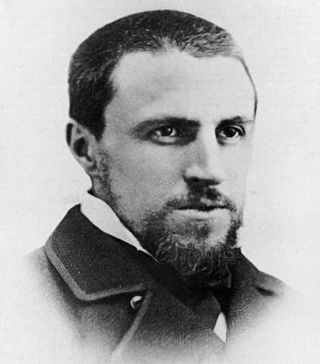
Chrysippus of Soli was a Greek Stoic philosopher. He was a native of Soli, Cilicia, but moved to Athens as a young man, where he became a pupil of the Stoic philosopher Cleanthes. When Cleanthes died, around 230 BC, Chrysippus became the third head of the Stoic school. A prolific writer, Chrysippus expanded the fundamental doctrines of Cleanthes' mentor Zeno of Citium, the founder and first head of the school, which earned him the title of the Second Founder of Stoicism.

The photophone is a telecommunications device that allows transmission of speech on a beam of light. It was invented jointly by Alexander Graham Bell and his assistant Charles Sumner Tainter on February 19, 1880, at Bell's laboratory at 1325 L Street in Washington, D.C. Both were later to become full associates in the Volta Laboratory Association, created and financed by Bell.

Pierre Paul Broca was a French physician, anatomist and anthropologist. He is best known for his research on Broca's area, a region of the frontal lobe that is named after him. Broca's area is involved with language. His work revealed that the brains of patients with aphasia contained lesions in a particular part of the cortex, in the left frontal region. This was the first anatomical proof of localization of brain function.

Gustave Caillebotte was a French painter who was a member and patron of the Impressionists, although he painted in a more realistic manner than many others in the group. Caillebotte was known for his early interest in photography as an art form.

Charles Augustin Sainte-Beuve was a French literary critic.

The Thinker, by Auguste Rodin, is a bronze sculpture situated atop a stone pedestal depicting a nude male figure of heroic size sitting on a rock. He is seen leaning over, his right elbow placed on his left thigh, holding the weight of his chin on the back of his right hand. The pose is one of deep thought and contemplation, and the statue is often used as an image to represent philosophy.

Giyasuddin Muhammad Uzbek Khan, better known as Özbeg (1282–1341), was the longest-reigning khan of the Golden Horde (1313–1341), under whose rule the state reached its zenith. He was succeeded by his son Tini Beg. He was the son of Toghrilcha and grandson of Mengu-Timur, who had been khan of the Golden Horde from 1266 to 1280.

Jesse Louis Lasky was an American pioneer motion picture producer who was a key founder of what was to become Paramount Pictures, and father of screenwriter Jesse L. Lasky Jr.
Hastings was an electoral district of the Legislative Assembly in the Australian state of New South Wales from 1859 to 1880. It was abolished in 1880 as part of the first major redistribution since 1858, replaced by Hastings and Manning from 1880 to 1894, which elected two members with voters casting two votes and the two leading candidates being elected. In 1894 it was divided between the single-member electoral district of Hastings and Macleay and Manning. In 1920 proportional representation was introduced and Hastings and Macleay was absorbed into the new four-member district of Oxley. The electorate was named after the Hastings, the alluvial valleys of which contained most of its population.

The Diocese of Saint-Claude is a Latin Church ecclesiastical territory or diocese of the Catholic Church in France. The diocese corresponds in territory to the department of Jura. It was created in 1742, as a smaller area, mostly consisting of some parishes previously controlled by the Abbey of Saint-Claude. Under the Concordat of 1802 the diocese was suppressed and its territory included in the Archdiocese of Besançon; in 1822 it was again made an independent diocese.

Damerey is a commune in the Saône-et-Loire department in the region of Bourgogne-Franche-Comté in eastern France.

The 1880 Michigan Wolverines football team represented the University of Michigan in the 1880 college football season. The team was the second intercollegiate football team to represent the University of Michigan. They played one game, defeating the team from the University of Toronto, 13 to 6, at the Toronto Lacrosse Club. Michigan scored two touchdowns and one goal; Toronto scored three safety touchdowns.
Diphtherophorina is a suborder of terrestrial nematodes, being one of three that constitute suborder Triplonchida.
Trichodoridae is a family of terrestrial root feeding nematodes, being one of two that constitute suborder Triplonchida. They are economically important plant parasites and virus vectors.
The Hastings and Manning, an electoral district of the Legislative Assembly in the Australian state of New South Wales was created in 1880 and abolished in 1894.
The Treaty of Paris of 14 March 1812 created an alliance between the Austrian Empire and the French Empire against the Russian Empire. Austria pledged to provide an auxiliary corps of 30,000 troops under the command of the French emperor, Napoleon Bonaparte, in the event of a war with Russia. The signatory for France was its foreign minister, the Duke of Bassano, and for Austria its ambassador in Paris, the Prince of Schwarzenberg. The treaty had nine public and eleven secret articles. The treaty was published in Le Moniteur Universel on 5 October 1813.










